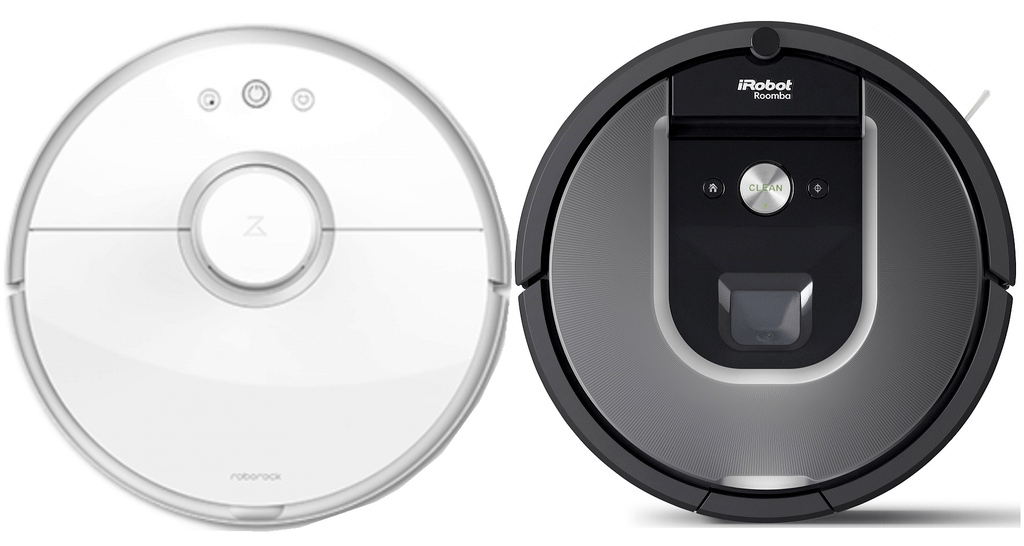The Roomba 960 is one of the most popular robot vacuums of all time. Even with newer technologies out there, the 960 remains an easy buy for its efficiency, thoroughness and now the lower price tag.
The Roborock S5 came along to take on all challengers and make a name for itself among the robot elite. With the ability to mop as its ace in the hole, how does it compare to one of the all time greats? In this article I will compare the Roborock S5 vs. the Roomba 960 to find out. Read on to find out why I say that the Roomba 960 is still the better buy.
Contents
Differences between the Roborock S5 and Roomba 960
The differences in the two robots may not be as surprising a list as you think, but it is an important one. Let’s take a look.
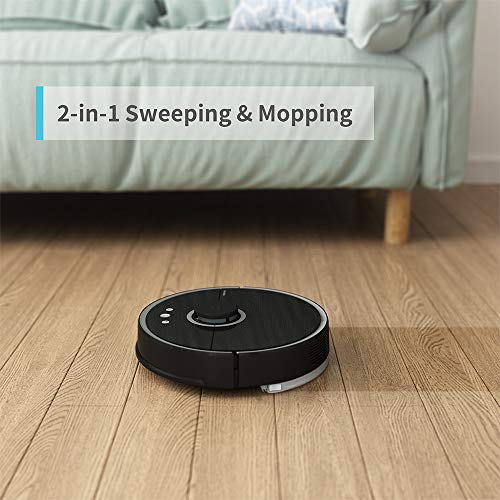
- The most obvious difference is that the Roborock S5 has the ability to mop your floors while the Roomba 960 only vacuums.
- Battery and runtime. The S5 has a much larger battery and longer runtime than the 960.
- Navigation and mapping. The Roomba 960 uses camera-based navigation called iAdapt 2.0, where the S5 uses laser-guided LDS navigation and mapping technologies.
- Noise levels. The Roborock S5 is notably quieter than the Roomba 960.
- Containment options. Roomba uses only physical containment barriers while the S5 uses only digital containment means.
Similarities of the Roborock S5 and Roomba 960
Being that both robots are cleaning robots, there are bound to be similarities. Check out the list below to find out what these two have in common.
- Recharge & Resume. Since both robots can map, they will have the ability to charge their own batteries and resume cleaning after the recharge, if needed.
- HEPA filtration. The 960 and S5 both use HEPA quality filtration to help keep allergens to a minimum.
- Scheduling and Programming. Both robots use wireless communications for mobile app, voice command and scheduling capabilities.
- Collection bin. The Roborock S5 and Roomba 960 both have a moderate 0.5L capacity collection bin.
- Side brush. You will find a single side brush used for both models.
- The companies each offer a 1-year warranty on these robot models.
Comparison Table
Have a look at all the features, dimensions and options of the two robots, side by side.
| Roborock S5 | Roomba 960 | |
| Dimensions | 13.7×13.8×3.8 inches | 13.8×13.8×3.6 inches |
| Weight | 7.7 pounds | 8.7 pounds |
| Battery | 5200mAh lithium-ion | 3600mAh lithium-ion |
| Runtime | Up to 150 minutes | Up to 120 minutes |
| Charge Time | 5 hours | 3 hours |
| Automatic Recharge | Yes | Yes |
| Automatic Resume | Yes | Yes |
| Filter | E-11 HEPA, washable | High-Efficiency |
| Motor Suction | Up to 2000pa | 1900pa |
| Scheduling | Yes | Yes |
| Spot Cleaning | Yes | Yes |
| Real Time Location and Programming | Yes | Yes |
| Wireless Communications | Yes | Yes |
| Local Controls | Yes | Yes |
| Mobile App | Yes | Yes |
| Voice Commands | Yes | Yes |
| Navigation | Multi-Sensor Multi-Room | Camera-Based Navigation |
| Mapping | LDS | iAdapt 2.0 |
| Collection Bin Capacity | 0.5L | 0.5L |
| Water Reservoir Capacity | 0.15L | N/A |
| Noise Level | 62dB | 67dB |
| Containment | Yes (app only) | Yes (physical only) |
| Side Brush | 1 | 1 |
| Floor Types | All | All |
| Damp Mop | Yes | N/A |
| Wet Mop | Yes | N/A |
| Warranty | 1 year | 1 year |
| Price | Check on Amazon | Check on Amazon |
Comparing the Roborock S5 to the Roomba 960 in Detail
Now that we know what the two robot cleaners offer you and how they perform based on their specifications and on-paper abilities, let’s look deeper. Below we will compare the various components and abilities against each other to find out who has the upper hand.
Roborock Mops, Roomba Not
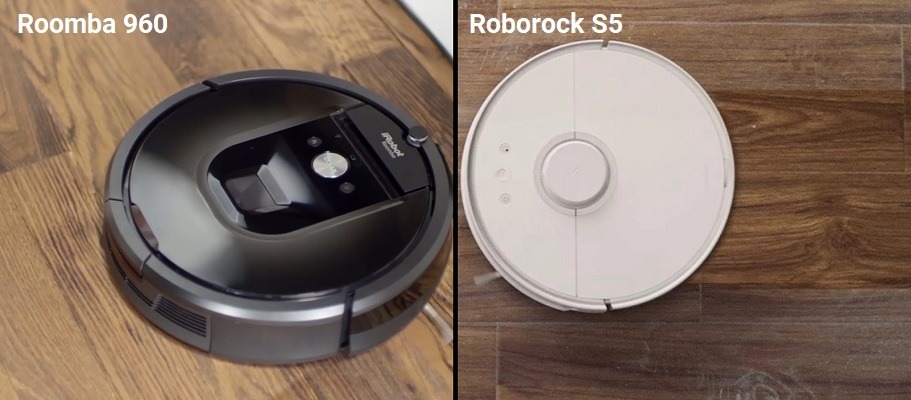
The largest and most glaring difference between the Roborock S5 and the Roomba 960 is that the S5 can mop your hard flooring. However, I wouldn’t get too excited about the prospect. It isn’t as amazing as it sounds.
The mopping feature is a true wet mop. There is a water reservoir that drips water onto the mopping pad and as the robot scurries around your floor. The problem is that there isn’t a scrubbing action, so the robot merely drags the wet pad around.
According to the Roborock instruction manual, you are expected to run the robot over the floor to be mopped at least three times in vacuum mode before you mop it.
If you have a 100 square foot kitchen, as an example, and follow the instructions completely, it will take the S5 about 4 hours to mop your floor. When it is done, the mopping pad will be dirty, which is a good thing, but your floors won’t appear much cleaner than if you only vacuumed over them.
For the time, effort and constant switching between modes, it would be more efficient and economical to use a real mop or a stick mop with a wet pad than it is to use the Roborock S5.
That being said, it does have mopping capabilities, which gives it a step up over the Roomba, if only barely.
Bottom Line: The Roborock mops. That is the only reason it can win this round over the Roomba 960.
The Robot Basics for the S5 and 960
All robots have basic and essential parts. The Roomba and Roborock have some things here in common and others are different. Let’s see how they work out for the specific models.
When it comes to powering the robots, the batteries both do a good job. The Roborock uses a 5200mAh battery that powers the robot, motor and sensors for up to 150 minutes. The robot does move slower than other models, but the additional runtime helps combat that issue.
The Roomba 960 has the newer 3300mAH battery that iRobot ran with in the 900 series, after a few upgrades and minimizing the number and types of batteries their robot lines used. With this battery the 960 can run up to a full 120 minutes, which should be enough time to cover almost every home layout in a single charge.
The Motors and Filters are Upgraded Over Previous Models
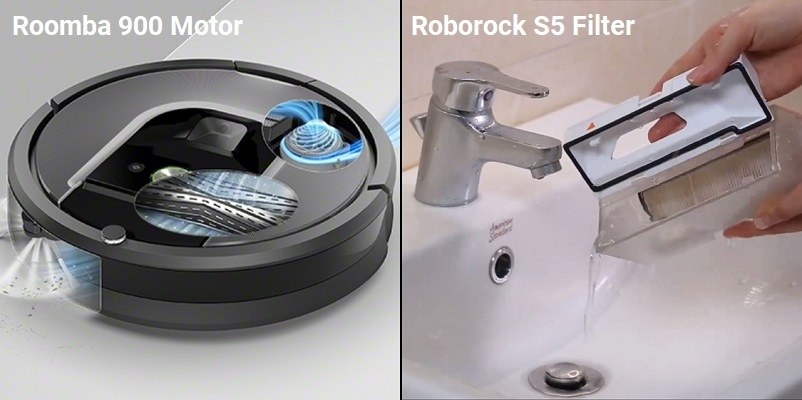
Compared to each model’s previous incarnation, the motors have seen an improvement. The Roborock got a small boost that produces an average of 2000pa of suction power. Compared to the S4 model, the difference isn’t as noticeable, but when the S5 is powering through carpet you will notice the uptick in power.
For the Roomba, the 960 takes advantage of a new motor (generation 2) that offers carpet boost technology. When on carpeting, the 960 will clean any carpeting type and rarely, if ever get stuck. Compared to the 800 series and early 900 series robots, the cleaning power is a drastic improvement.
The filters are basically unchanged. The Roborock has a slight advantage here as the HEPA filter it uses is washable. You can effectively go about 6 to 9 months before it needs to be replaced, assuming you wash the filter weekly.
The Roomba 960 also uses a HEPA quality filter, but it is disposable. With standard use, the filter will need replacement about every 4 months.
Side Brushes and Extractors
Both robots use a single side brush to get along edges and into corners. Neither robot is exactly proficient at this process. Both models will get along the edges fairly well, though the Roomba does have a small advantage here because of the angled approach of the side brush.
In the corners, though, both are about equal. They will get what they can and it will be noticeable, but they won’t get everything. For both the S5 and 960 you will need to assist them with your broom when it comes to corner cleaning.
The main extractors, though, are a little different. Roborock uses a single bristled brush roller. It has a mixture of soft and hard bristles that work to sweep hard flooring and lift debris from carpeting. Because of the bristles, the brushroll gets easily wrapped with hair and larger debris which needs more attention to clean and care for.
On the other hand, the 960 uses dual brushless extractors that have rubber paddles instead of brushes. They don’t get as easily tangled with anything and can even free themselves from larger debris tangles or if they happen to roll over a power cord.
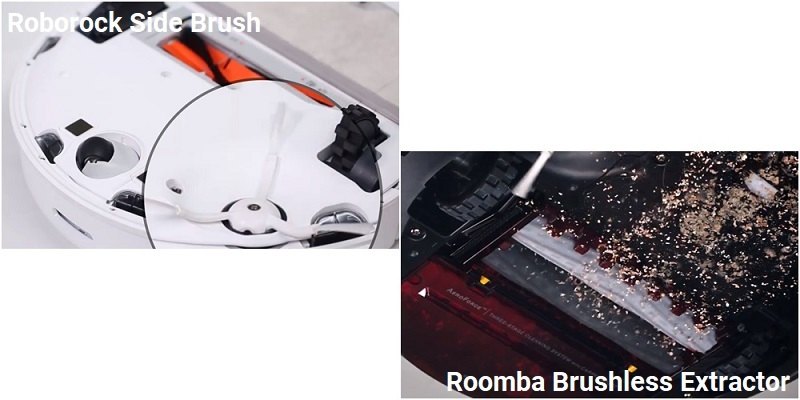
Bottom Line: The Roomba 960 has a slight advantage with the basic functionality. The better extractors and motor on carpet is a clear win for the robot giant iRobot.
Control Options for the Roborock and Roomba Robots
Controlling your robots is one of the more fun aspects of ownership. Both the Roborock S5 and the Roomba 960 offer three control methods. The local controls are getting less and less as time goes on, but for now, they still exist.
With the Roomba you have three options. You can start a standard cleaning cycle, send the robot back to the charging dock or perform a spot clean.
Voice Commands Lean to the Roomba model
The Roborock S5 Alexa and Google voice commands are quite limited. In fact, you can either start a cleaning session or end one with your voice. While these options are limited, they do work well enough.
The Roomba 960, though, is quite inclusive with Alexa commands. You can start and stop a cleaning cycle, of course. You can also pause and resume, send the robot to the charging station, set, edit or cancel a scheduled cleaning.
Beyond that you can also find out where the robot is located, as well as finding out status information and more. The Roomba i– and s-series robots have even more voice commands, they just work with features that the 960 model doesn’t have.
The Mobile App is King and Both Robots Offer Decent Choices
For the Roomba 960, the iRobot Home app is one of the most inclusive, user-friendly and simple robot apps available. It is arguably the best, feature-filled app on the market. You have all of the same controls through the app that you have with the voice commands listed above.
However, you also get to see the map the robot creates. While there isn’t any interaction with the map, you can see where the robot has been, what is left to clean, and check on the battery and cleaning session statuses.
The Roborock app offers all the control options there are, along with the map the S5 creates. However, with this map you have interaction. The containment for Roborock vacuums is all digital (more detail below). Along with taking full control of the robot you can tell it where to go, when and what to avoid.
The main problem, though, is that while all the right features are there, they don’t all work as expected. Roborock is aware of the app issues and pushes out new updates constantly to address them. While they still have some kinks to work out, it is a lot better than it was a year ago.
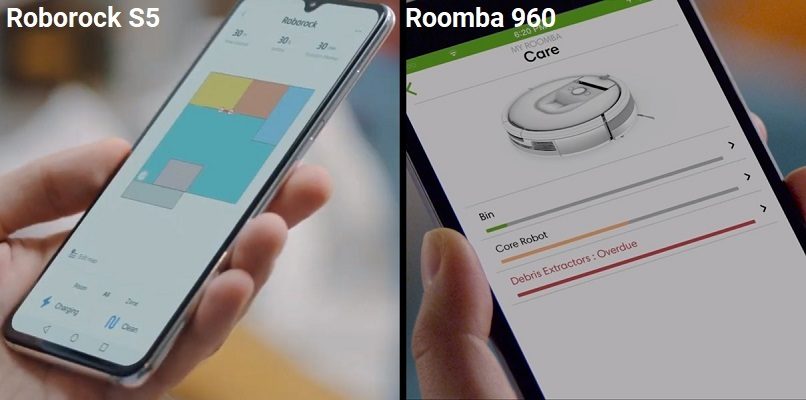
Bottom Line: The Roomba 960 gets the nod here again. The control options are more robust across the board and work without constant app updates.
How to Contain the Roomba 960 and Roborock S5
Containment is an important factor when it comes to robot cleaners. Depending on the season, you may have a tree in your home you don’t want the robot to get near. You may have pet dishes that need to be avoided, or perhaps the kid hasn’t cleaned up all his Lego yet.
Whatever the reason or the season, you need to be able to contain the robots. Roomba has one of the easiest to use methods known as dual-mode virtual wall barriers. These battery-operated towers use infrared beams to control where the robot can or cannot go.
In linear mode the light comes out in a straight line, up to 10 feet. It is ideal for blocking off entrances or exits, or even blocking off portions of entire rooms. In halo mode, the light beam is a circle that comes out up to 4-feet from the tower. This mode is perfect for protecting pet dishes or Christmas trees.
The Roborock S5 has digital containment. Instead of a physical tower and infrared lights, all containment comes through the app. The first portion is No-Go lines. On the map created in the mobile app, you are able to draw lines and squares anywhere you like. These areas are considered off-limits. When the robot runs around the home, the No-GO lines are uploaded to the robot’s map and, ideally, the robot treats them like a physical wall.
In the real world, though, the S5 is known to ignore these lines, or end up on the wrong side of the barrier, cleaning where it shouldn’t. These small issues are being worked on, though, and newer versions of the app limit the occurrences of this problem.
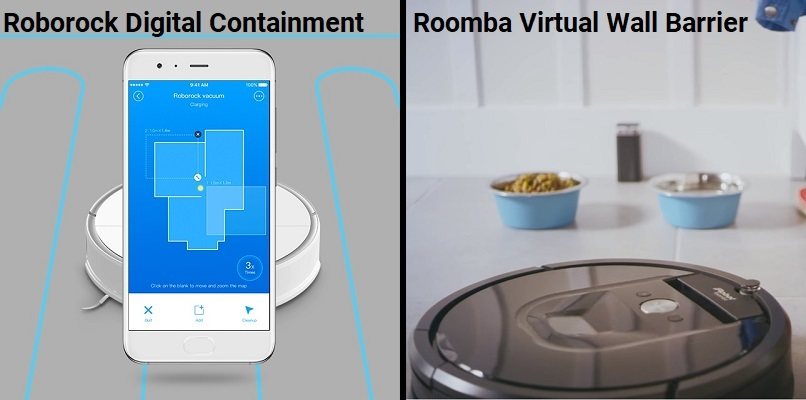
Bottom Line: The Roomba wins again. The containment may not be digital, but it works without waiting for updates.
Real-World Cleaning Abilities
Seeing the robot commercials or watching YouTube videos is great for seeing the robots. If you are interested in how they perform in strict “lab conditions,” this may be enough for you. But I am more interested in how they operate and function when you get them home and set the robots loose on your floors at home.
This section will outline how well they clean in various situations and deal with some of the most common things round our homes. All without the pre-measured, controlled spills or small operating areas on carpet that has never seen a human foot before.
The Robots on Carpeting
When it comes to carpeting, there really isn’t a competition. The Roomba 960 is going to win every time. The S5 does well at cleaning back and forth human-like patterns and doesn’t miss a whole lot of areas. However, with the single brush roller and not much carpet agitation, your thicker carpets aren’t going to be amazingly clean.
The 960, though, will clean all carpets, not just low-pile, like the Roborock model. With the brushless extractors, it won’t get stuck on power cords or those random socks that seem to appear out of nowhere.
The Roomba 960 cleans a little faster, a lot deeper and is more thorough compared to the Roborock S5. But what about pet hair? The Roomba has a huge advantage here.
The rubber paddles on the extractor rollers work to separate the pet hairs, human hairs and strings that cause bristle rollers to clog. They also untangle each other as they spin. Now you will have to clean them off. They aren’t immune to wraps and tangles.
The difference here is that the Roborock S5 brush roller will get wrapped and the clean up process can take 10 minutes or more. To clean the Roomba 960 rollers, it takes about 45 seconds.
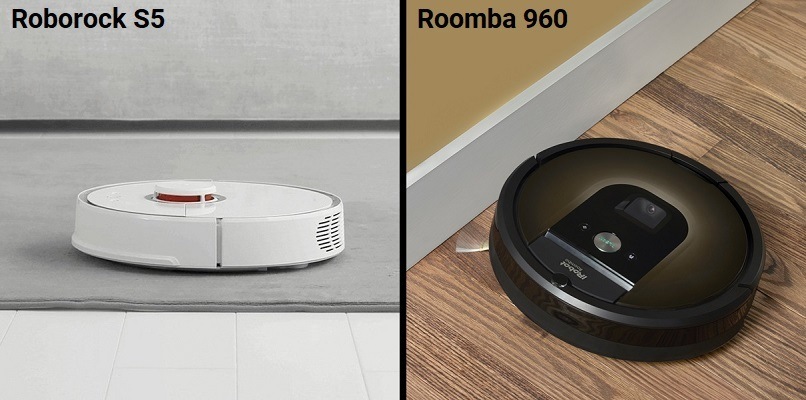
The Robots on Hard Flooring
On hard flooring, the robots are a little more equal. I’ve already discussed how they do along the edges and getting into corners. However, in the middle of the floor the robots will do quite an incredible job.
The one small disadvantage here is that the S5 bristles do have some stiffness to them. On the softest of flooring, there have been a few scattered reports of the robot leaving scratches. If you have softwood flooring or a sealant on top of your floor, you may want to test in a small area prior to letting the robot run loose.
The Roomba 960 has a high-speed side brush, though, and mixed with the non-diffused exhaust air, lighter debris can be kicked around. That being the case, it looks as if the robot is making a bigger mess than it is cleaning up. However, by the end of the cycle, everything is collected.
Bottom Line: The Roomba 960 wins yet again. A better cleaning on more types of carpeting and the rollers won’t get as tangled with pet hair. It’s an easy win here.
Frequently Asked Questions
Here, I will answer some of the most common questions about the two robot models. If you have other questions still, feel free to use the comment section below the article and I’ll have an answer for you quickly.
Q. How do I contact iRobot customer service?
A. You can call iRobot at any time by calling toll-free 1-800-727-9077. If you are looking for other methods of contact or are outside the US, you can find email addresses to various customer service departments or tech support, as well as a live chat option on the iRobot contact page.
Q. How do I contact Roborock customer service?
A. Currently the only method of contact with Roborock is through email. You can email them at support@roborock.com. The expected turnaround time is about 48 hours, but usually you will have a response the next business day.
Q. Will I get a warranty with these robots?
A. Both the Roborock S5 and Roomba 960 come with a 1-year limited warranty. This will include the battery for both models. However, neither warranty will cover the filters, rollers, side brush or wheels. You will need to register your purchase with both companies for the warranties to take effect.
Q. Where is the best place to buy a Roomba 960 or Roborock S5?
A. Currently, the only place to buy a Roborock vacuum is through Amazon. While they are attempting to create a sales page on the Roborock website, it isn’t active yet. If you are looking for the Roomba 960, you can still buy this model through the iRobot website, but the lowest price and best shipping deals will come through Amazon.
What I Like About the Roborock S5
- While mopping can be improved, it is an option and that is always a bonus.
- Extra long battery life for a longer cleaning time.
- Digital containment and a thorough mobile app
What I Like About the Roomba 960
- Industry leading mobile app controls.
- Complete and thorough voice commands through Alexa or Google.
- Rubber extractors are simple to clean and untangle themselves.
In Conclusion
Choosing the right robot cleaner for your home is a difficult process. You have hundreds of models to choose from. Each one vies for your attention with features, options or low prices. However, the choice is made easier by knowing what you want, what you need to expect form the robots and how much you need to rely on them.
The Roborock S5 isn’t the best model in the Roborock line up, but it is formidable in its own right. The mobile app controls and decent cleaning ability keep it a popular model. Compared to the Roomba 960, though, it doesn’t hold up. The 960 has a better app, deeper cleaning and outperforms the S5 in almost every area. For the price, the choice is simple; go with the Roomba 960.
